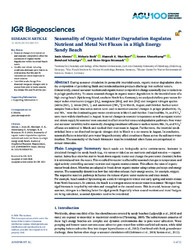Seasonality of Organic Matter Degradation Regulates Nutrient and Metal Net Fluxes in a High Energy Sandy Beach
DOI: https://doi.org/10.1029/2019JG005399
Persistent URL: http://resolver.sub.uni-goettingen.de/purl?gldocs-11858/9137
Persistent URL: http://resolver.sub.uni-goettingen.de/purl?gldocs-11858/9137
Ahrens, Janis; Beck, Melanie; Marchant, Hannah K.; Ahmerkamp, Soeren; Schnetger, Bernhard; Brumsack, Hans-Jürgen, 2020: Seasonality of Organic Matter Degradation Regulates Nutrient and Metal Net Fluxes in a High Energy Sandy Beach. In: Journal of Geophysical Research: Biogeosciences, Band 125, 2, DOI: 10.1029/2019JG005399.
 |
Dokument öffnen: |
During seawater circulation in permeable intertidal sands, organic matter degradation alters the composition of percolating fluids and remineralization products discharge into surficial waters. Concurrently, coastal seawater nutrient and organic matter composition change seasonally due to variations in pelagic productivity. To assess seasonal changes in organic matter degradation in the intertidal zone of a high energy beach (Spiekeroog Island, southern North Sea, Germany), we analyzed shallow pore waters for major redox constituents (oxygen [O2], manganese [Mn], and iron [Fe]) and inorganic nitrogen species (nitrite [NO2−], nitrate [NO3−], and ammonium [NH4+]) in March, August, and October. Surface water samples from a local time series station were used to monitor seasonal changes in pelagic productivity. O2 and NO3− were the dominating pore water constituents in March and October. Dissolved Mn, Fe, and NH4+ were more widely distributed in August. Seasonal changes in seawater temperature as well as organic matter and nitrate supply by seawater were assumed to affect microbial rates and degradation pathways. Pore water and seawater variability led to seasonally changing constituent effluxes to surface waters. Mn, Fe, and NH4+ effluxes are minimal in March and reached their maximum in August. Furthermore, the intertidal sands switched from a net dissolved inorganic nitrogen sink in March to a net source in August. In conclusion, seasonal effects on intertidal pore water biogeochemistry affect constituent fluxes across the sediment-water interface. The seasonality of the beach bioreactor must be considered when fluxes are extrapolated to annual timescales.
Statistik:
ZugriffsstatistikSammlung:
This is an open access article under the terms of the Creative Commons Attribution License, which permits use, distribution and reproduction in any medium, provided the original work is properly cited.

